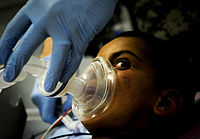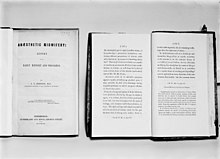
Back Narkose AF تخدير Arabic Anestesia AST Anesteziya AZ Анестэзія BE Анэстэзія BE-X-OLD Pemba'alan BEW Анестезия Bulgarian एनेस्थीसिया BH অবেদন Bengali/Bangla


An anaesthetic (anesthetic) is a substance that either stops pain, or causes the user to sleep. There are two types: general anaesthesia causes a reversible loss of consciousness. Local anaesthetic cause a loss of sensitivity (and pain) on a local area.
Anaesthetics can be rubbed onto the skin, given by injection ("shot"), or given as a gas to breathe. Anaesthesia blocks pain during operations. This lets patients undergo surgery and other procedures without the distress and pain they would normally feel. It comes from the Greek roots an-, "without" and aesthetos, "perceptible, able to feel".
The most famous anaesthetic, ether, may have been made as early as the 8th century,[1][2][3] but it took many centuries for its anaesthetic importance to be appreciated
The history of modern anaesthetic began with Joseph Lister. Before it, people sometimes used cocaine, alcohol, and other drugs to get the same effects. Modern anaesthesia is complex, with a combination of anesthesia, analgesia and muscle relaxation. These three are known as the "triad of anesthesia".
The most famous anesthetic, ether, may have been synthesized as early as the 8th century,[1][2] but it took many centuries for its anesthetic importance to be appreciated
- ↑ 1.0 1.1 Toski JA, Bacon DR, Calverley RK (2001). "The history of Anesthesiology". In Barash PG, Cullen BF, Stoelting RK (eds.). Clinical Anesthesia (4th ed.). Lippincott Williams & Wilkins. p. 3. ISBN 978-0-7817-2268-1.
- ↑ 2.0 2.1 Hademenos GJ, Murphree S, Zahler K, Warner JM (2008). McGraw-Hill's PCAT. McGraw-Hill. p. 39. ISBN 978-0-07-160045-3.
- ↑ Evans TC (1928). "The opium question, with special reference to Persia (book review)". Transactions of the Royal Society of Tropical Medicine and Hygiene. 21 (4): 339–40. doi:10.1016/S0035-9203(28)90031-0. The earliest known mention of the poppy is in the language of the Sumerians, a non-Semitic people who descended from the uplands of Central Asia into Southern Mesopotamia ...